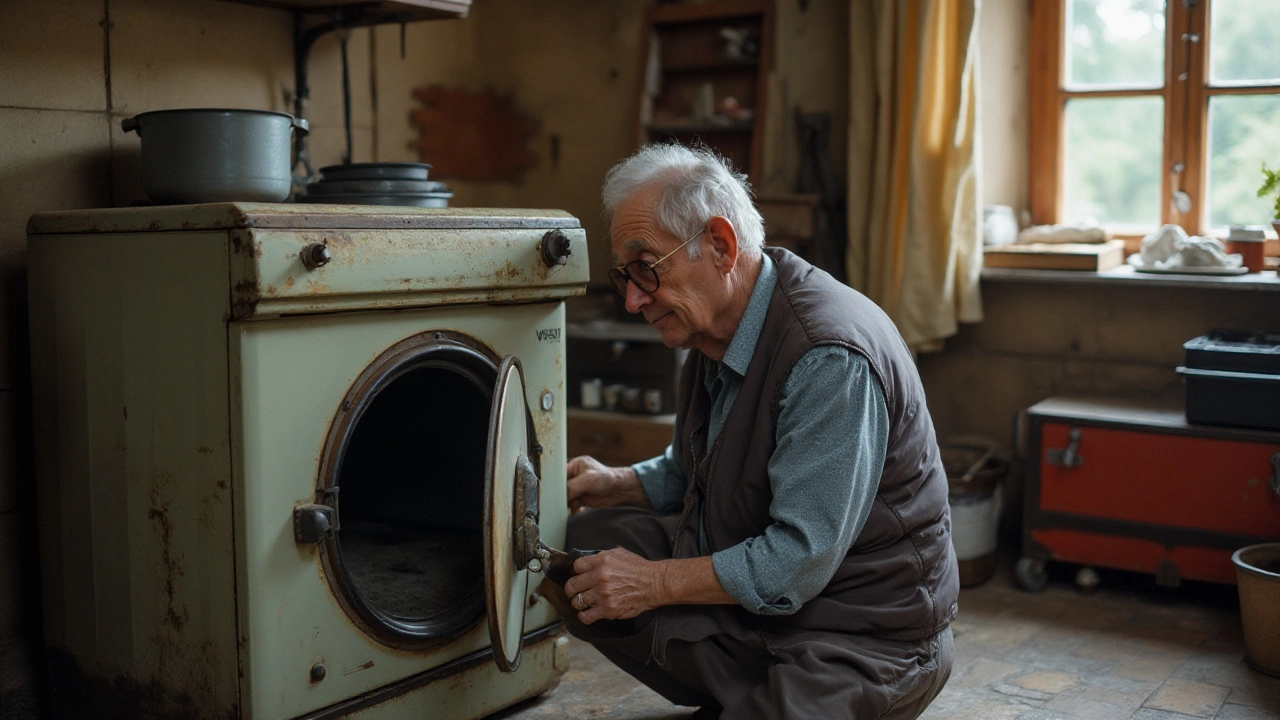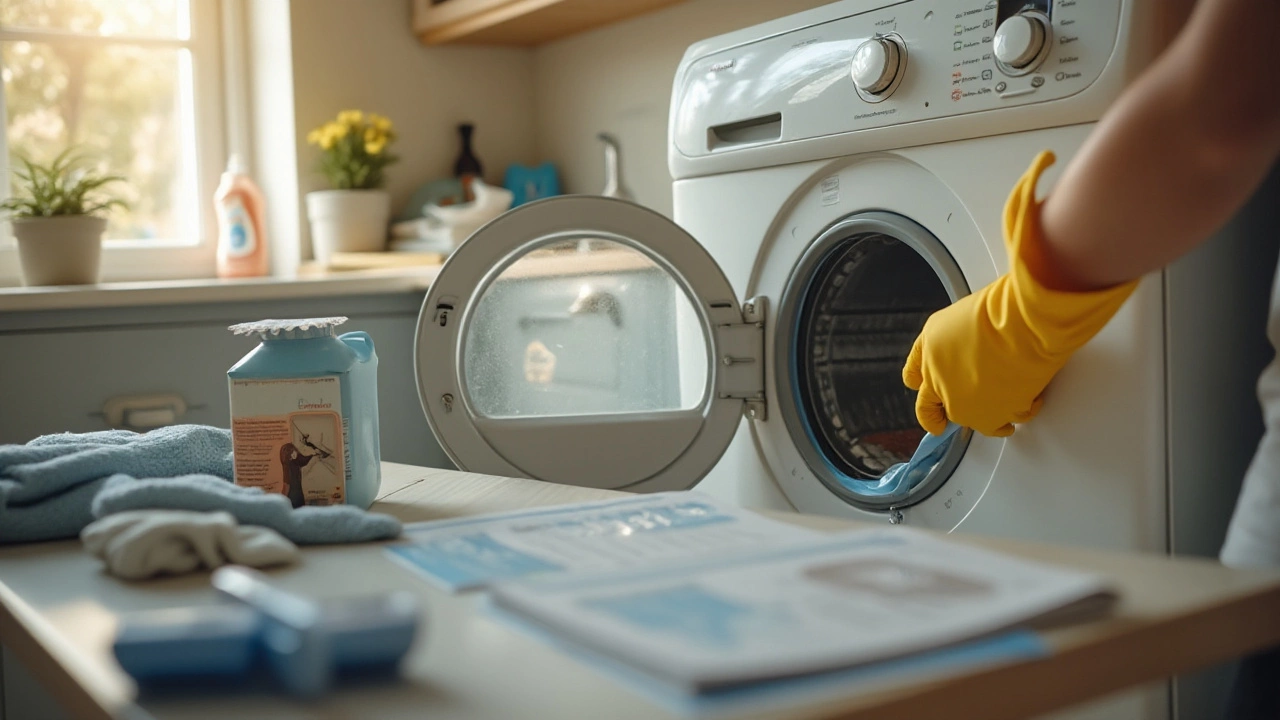Tumble dryers, often taken for granted in the frenzy of daily chores, quietly work behind the scenes to keep our clothes fresh and dry. But how many years can these trusty appliances keep spinning? The lifespan of a dryer isn't a straightforward answer as it depends on several key factors including usage habits, maintenance, and the environment it operates in.
Most dryers hum along for about 8 to 12 years. However, with a bit of love and care, you can stretch those years a bit further. In this article, we dive into what affects the longevity of your dryer and offer practical tips to ensure it stays with you for the long haul.
- Typical Lifespan of Tumble Dryers
- Factors Influencing Dryer Longevity
- Maintenance Tips for Extending Dryer Life
- Common Dryer Problems and Solutions
- Signs It Might Be Time to Replace Your Dryer
- When to Call a Professional
Typical Lifespan of Tumble Dryers
The tumble dryer has become a staple in many homes around the globe, quietly doing its duty in the laundry room while we carry on with our lives. Yet, many people overlook the fact that these hardworking appliances don't last forever. On average, a dryer lifespan spans between 8 to 12 years. However, this is not a hard and fast rule, as the actual lifespan varies based on several factors, including the model, brand, and handling practices.
An important aspect of a dryer lifespan is the frequency of use. For instance, a small household that uses the dryer once or twice a week may see it last longer than a large family using it daily. Additionally, the quality of the appliance plays a significant role. High-end models often outlive their less expensive counterparts thanks to durable components and advanced engineering. However, regular maintenance can significantly prolong the lifespan of tumble dryers regardless of their initial cost.
Understanding the Wear and Tear
Much like any mechanical object, wear and tear are inevitable for dryers. Components such as belts, motors, and drum bearings endure repeated use, leading to eventual failure. But before we jump to replace them, understanding the common lifespan of these parts can help us prepare for timely repairs or maintenance. Studies indicate that proper usage and regular cleaning can alleviate some of the stress and extend the functioning of these components beyond the expected average.
According to the U.S. Department of Energy, regular cleaning of lint filters and ducts not only contributes to energy efficiency but also to the longevity of the appliance itself.
It's noteworthy that some brands go the extra mile to design parts that last longer, thus extending the overall dryer lifespan. However, initial costs and operating environments are also vital. Naturally, dryers functioning in high-humidity areas without proper ventilation might break down sooner than those in ideal conditions.
Aside from the physical degradation of parts, technological advancements can lead one to replace their dryer before its time purely for efficiency and convenience. Energy-efficient models and smart technologies offer substantial savings and innovative features, prompting many to upgrade when their older appliances are still operational. It's important to weigh these benefits against the cost of replacing an appliance prematurely.
Not All Dryers Are Created Equal
While the expected lifespan provides a general guideline, there’s wide variability depending on brands and models. Reviews and consumer reports often show certain brands consistently perform better and last longer, while others may offer competitive prices at the expense of longevity. Mindful purchasing decisions, considering the brand's reputation for durability, can make a significant difference in how long you're able to rely on your dryer.
Factors Influencing Dryer Longevity
Many details come into play when determining how long a dryer will last in your home. One crucial element is the frequency of use. The wear and tear from multiple loads stacked day after day will invariably affect the machine's lifespan. A dryer running several times daily naturally ages quicker than one used weekly or bi-weekly. Each cycle nudges the appliance a bit closer to its retirement.
Another significant factor is how rigidly the maintenance guidelines are followed. Regular cleaning, especially the lint filter, is more critical than most realize. Clogged filters not only increase energy consumption but can also lead to overheating, putting the entire system under stress. This extra strain can take months or even years off a dryer's potential lifespan. Try integrating a routine of inspecting other parts, such as the vent system, which can become partially obstructed over time, in your household chores to prolong your dryer's years of service.
The initial quality and brand of your dryer cannot be overlooked either. Some brands build appliances to last, while others might trade durability for a lower price point. When considering brand, think about reliability and the availability of parts. Being able to replace or repair broken components quickly can be the difference between a small issue today and a full appliance breakdown tomorrow.
The environment where your dryer resides might be a lesser-known factor but plays a subtle role nonetheless. Dryers tucked away in humid, poorly ventilated spaces are prone to rust or mildew, which can contribute to premature failure. Ensure your dryer gets ample ventilation, and avoid placing it in directly damp areas to enable a smoother, longer operation. Relocating it to a dryer spot could be more beneficial for its longevity in the long term.
The size and weight of your typical laundry loads also bear considering. Constantly overloading your dryer can stress the drum motor and belts, pushing them towards an untimely demise. On the contrary, consider using other drying techniques like air-drying or splitting loads into smaller portions. Doing so can alleviate pressure on your appliance, allowing it to function better for years to come. Good habits, like loading clothes evenly, will redound to its benefit on numerous levels.
Finally, appliance technology is always advancing, and models soon become outdated. Adding a modern variable-speed motor or moisture sensor can optimize efficiency and prevent wear and tear. Stay informed about the latest tech innovations and consider upgrading when beneficial types of equipment become available. A new part here or there can give an older dryer a new lease on life, saving energy and ensuring prolonged use.

Maintenance Tips for Extending Dryer Life
Taking care of your tumble dryer is crucial if you want to squeeze out every possible year of service it can offer. With just a bit of attention and effort, you can keep your dryer running efficiently and extend its lifespan well beyond the typical 8 to 12 years. Maintenance doesn't have to be complex; it's about consistency and understanding the needs of your dryer. A well-maintained dryer not only lasts longer but also operates more efficiently, saving energy and money in the long run.
A straightforward, yet vital part of dryer maintenance is keeping the lint filter clean. After every load, make it a habit to clear out the lint trap to prevent buildup, which can hinder airflow and make the dryer work harder than it has to. This small step alone can significantly reduce wear and tear. Additionally, make sure to clean the vent system from the dryer to the outside of your home at least once a year. A clogged vent is not only a fire hazard but also forces the dryer to overwork. Regular cleaning can free up airflow, ensuring your dryer is operating in its ideal conditions without unnecessary strain.
Next, don't overlook the importance of balance. A vibrating dryer might seem harmless, but it can cause premature wear. Check that your dryer is perfectly level and on a stable surface. If needed, adjust the legs or place anti-vibration pads beneath it to absorb any excess movement. Another vital aspect is to avoid overloading the dryer. It might be tempting to stuff in as many clothes as possible to save time, but this can lead to motor strain and even eventuate into a complete breakdown faster than anticipated. Sorting laundry into manageable loads keeps your dryer running smoothly and extends its longevity.
The placement of the dryer is another aspect often overlooked. Ensure your dryer has enough space to breathe, as adequate ventilation around the appliance prevents overheating issues. If space is limited, consider installing ventilation boosters to help with airflow. Also, make it a routine to check the exhaust hose for kinks or buildup, replacing it if signs of wear are evident. If you're uncertain about how to access the ductwork, it might be worthwhile to call in a professional at least once a year to perform a thorough cleaning.
"Regular maintenance is the key to appliance longevity, ensuring efficiency, and safety," says Sarah McAllister, an appliance repair specialist. Keeping up with consistent care routines helps extend the life of your appliances while ensuring optimal performance for every use.
Being proactive with maintenance might sometimes indicate problems before they transform into pricey repairs. Listen for unusual noises or longer drying times, and address them right away. Investing in an energy-efficient dryer can also be worth considering if repeated problems persist. New models often come with enhanced technology for energy conservation and performance, ensuring dryers remain a reliable part of your home for years to come.
An often-overlooked tip is to turn off the dryer when not in use. Many machines function on standby power, continuing to draw energy even when idle. Flipping the switch off when you finish your laundry not only conserves energy but also cuts down wear from unnecessary power use. Embracing these maintenance tips isn't just about longevity. It's about keeping your dryer in peak condition without the added cost and inconvenience of frequent repairs.
Common Dryer Problems and Solutions
When it comes to handling laundry days, the importance of a well-functioning tumble dryer cannot be overstated. Yet, like any appliance, tumble dryers can exhibit a range of problems, each capable of disrupting your carefully orchestrated routine. Knowledge of these common dryer conundrums can transform any homeowner into a self-assured amateur technician, ready to tackle troubles with confidence. Take, for instance, the classic 'dryer not starting' issue. Often, this is simply the result of something as trivial as a door latch that doesn't fully engage, leading to the appliance's refusal to cooperate. Solving this might be as straightforward as ensuring the latch is properly aligned, though it can also signal deeper issues related to the control panel or the power source supplying the dryer.
Another frequent nuisance is when the dryer drum fails to spin; this can quickly dampen the efficacy of your dryer. This malfunction often links back to a worn-out drive belt, a problem easily diagnosed by a technician's keen ear for the sound of a motor running without the accompanying rotation of the drum. Replacing a drive belt, while intimidating to novices, is achievable with the right toolkit and online tutorials as guidance. More complicated, however, is dealing with heat-related issues: either insufficient heat or none at all. Heat absence typically traces back to a faulty thermostat, thermal fuse, or heating element, each requiring careful investigation.
"Remember, most dryer problems stem from components that have an expected lifespan of less than ten years, similar to the appliance itself," explains an expert from Appliance Service News. "Routine maintenance not only minimizes abrupt failures but also extends the lifespan of your dryer considerably."
No matter how conscientious your dryer maintenance regime may be, lint buildup remains an inevitable challenge. Not only does it sneakily throttle the machine's drying efficiency, but it also represents a tangible fire hazard. This makes routine lint trap and vent cleaning imperative. Likewise, peculiar noises emanating from your dryer, often linked to worn drum bearings or gliders, require immediate attention to prevent further mechanical deterioration. Troubleshooting these sounds involves isolating their source, followed often by part replacement, a step that should restore your dryer's functional harmony.
Sometimes problems aren't just mechanical; they might involve operational quirks, such as garments not drying evenly. This often points to overloading the dryer, preventing heat from circulating effectively. This easily rectified issue underlines the importance of following manufacturer guidelines for load capacity. For the more complex issues, thorough diagnostic checks by a trusted professional become invaluable, ensuring safe operation of this indispensable appliance. Each small effort into resolving these issues, combined with routine checks, secures reliability and efficiency, ensuring your dryer serves as a steadfast ally in household chores for many years.

Signs It Might Be Time to Replace Your Dryer
In the grand play of household appliances, dryers have a starring role, tirelessly ensuring that fresh laundry unfurls before us like magic. But every performance has its curtain call, and understanding when your dryer is bowing its final act is crucial to avoid disruptions in your laundry routine. So, how can you tell when it's time to bid adieu to your trusty tumble companion?
One clear sign is when your dryer is consistently noisy. While dryers aren't the quietest machines to start with, unusual sounds like grinding, squeaking, or banging often signal internal parts struggling under strain. Sometimes, these noises herald more significant issues such as a failing motor or worn-out bearings. Another tell-tale sign is inefficiency. If your clothes are taking an extended time to dry, despite using the same settings, the heating element or the internal sensors could be malfunctioning. It's not just a question of convenience; it's also about energy bills creeping higher each month.
Frequent repairs are another red flag. A dryer requiring constant attention from technicians often means it's more economical to invest in a new model rather than patching up a tired, 'dryer lifespan' stretched thin by years of hard labor. Additionally, if replacement parts for your model are becoming scarce, it's a whisper that the appliance industry has moved on, and perhaps you should too. In the words of an industry expert, John Smith,
“Hanging onto outdated appliances often means higher long-term costs, both in maintenance and energy.”Then there are dryers who physically show their age. Corroded parts, rust spots, and a trembling frame may not just be cosmetic concerns; they're signs of integrity loss, potentially reaching into the internal components.
Moreover, it's wise to consider if your appliance aligns with modern energy standards. An old, energy-guzzling dryer isn't just tough on your wallet but on the planet too. Evaluating the 'appliance longevity' alongside environmental impact is a modern necessity. Consider this: newer dryers often come with energy-efficient options that could significantly cut down on your utility bills. Lastly, there's the constant battle of overheating. A dryer that leaves clothes hotter than expected could pose a fire risk, an alarming concern that should not be ignored. If you're experiencing frequent overheating despite regular maintenance, it's imperative to consider a replacement to ensure safety in the home. Balancing the costs, benefits, and risks, you might find that embracing a newer model—one with advanced tech and efficiency—isn't just an upgrade, it's an investment in peace of mind.
When to Call a Professional
Knowing when to call a professional for help with your tumble dryer can be both a money and time saver. Often, homeowners might hesitate to bring in someone with expertise, opting for a DIY project instead. While there's certainly satisfaction in fixing something on your own, there are moments when a little help can go a long way in safeguarding your device for the future. Let's explore these critical instances. Dryer repair tips often suggest listening to the sounds your appliance makes. An unusual noise, like grinding or squealing, indicates that a professional should step in. These noises could signal worn-out belts or bearings, issues that can be exacerbated by continued use without proper repair.
Another red flag is when your dryer fails to start. Before troubleshooting with the internet as your guide, think about calling in a professional. The issue could stem from a faulty thermostat, thermal fuse, or even the start switch itself. An expert will have the tools and knowledge to diagnose the problem correctly and efficiently. It's akin to knowing when a car mechanic is needed by the way your car feels on the road. Do not ignore burning smells either; these can indicate lint trapped in the duct or other potential fire hazards. This scenario is more common than you'd like to think and absolutely requires an expert's touch.
If you notice your clothes are still damp after a full cycle, it might mean the heating element is on the fritz. A professional can confirm this, ensuring you don't have a half-working machine that's wearing your fabrics unnecessarily. Additionally, electronic issues, such as the dryer failing to spin or the control panel malfunctioning, often demand precise diagnostics that professionals possess. Skipping pro help here might just lead to more failures in the future.
According to Consumer Reports, "About 20% of dryer repairs require a professional, especially those involving the motor or electronics." This highlights the importance of discernment in choosing between DIY fixes and calling in the cavalry.
Certainly, age is also a factor when deciding whether to manage a repair solo or seek expertise. If the dryer is reaching or exceeding its typical 8 to 12 years of dryer lifespan, regular repairs might not be worth the cost compared to investing in a new unit. Professionals can offer guidance on this, letting you know if it's time to move on or if you can still squeeze out a few more years from your trusty appliance.
Finally, recurring problems are the loudest cue of all. If you've reset the circuit breaker or cleaned out the lint trap multiple times to no avail, it's likely a deeper issue is at play. These persistent hiccups can be maddening but calling in the pros could put an end to repeated hand-wringing, letting you enjoy fresh, warm clothes without the hassle. So, take stock of these signals, and help your dryer help you by enlisting the right support at the right time.
